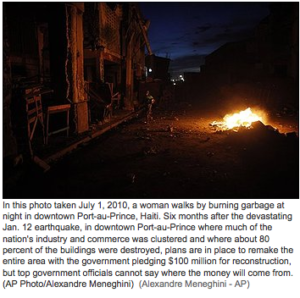The Associated Press
Sunday, July 11, 2010; 12:26 AM
CORAIL-CESSELESSE, Haiti — The sun was beating down on the rocky cactus plain when men with machetes came for Menmen Villase, nine months pregnant, shoved her onto her bulging stomach and sliced up the plastic tarp that sheltered her and her four children.
The family was one of thousands of earthquake homeless who had come to this Manhattan-sized stretch of disused sugarcane land between the sea and barren mountains north of Port-au-Prince, seeking refuge from overflowing camps in the city.
But this real estate is earmarked for building a new Haiti. Villase had walked into one of the fights over land, rooted in Haiti’s history of slavery, occupation and upheaval, that have bedeviled recovery in the six months since the earthquake leveled much of the capital and killed as many as 300,000 people.
The government, already weak before the magnitude-7 quake and still hobbled by its aftermath, is trying to build anew in places like Corail-Cesselesse, a nearly empty swath of land that begins about 15 kilometers (9 miles) north of the capital. But the effort is paralyzed by disorganization, bitter rivalries and private deals being struck behind its back.
Multiple families claim title to almost every scrap of real estate. Already one reconstruction official has been forced to step down for steering a public project to his company’s private land at Corail-Cesselesse. Wealthy landowners vow the “new Haiti” will become yet another vast slum unless the government rebuilds on their terms.
Caught in the middle are the homeless, looking to grab a patch of ground from the thugs hired to keep them away. Even facing machetes, Villase had to be dragged from the tarp that was home for her and four children.
“I didn’t want them to take the tent away,” she recalled. “They said, ‘We don’t care. We can rip it up while you’re inside.'”
—
In the moments after the disaster all Port-au-Prince began pouring into twilit streets. Homes, still collapsing, had in a moment become death traps. Camps rose on public and private spaces, squares, parks and golf courses.
Bodies were everywhere, laid out under sheets, cardboard or nothing. Dump trucks and front-loaders cleared most in the following weeks. Others were burned. Some are still being found.
The bodies have been cleared, but not the estimated 20 million cubic meters (yards) of rubble. Mounds of it make most of the capital impassable. Even with 300 trucks working daily, only two percent has been cleared.
The number of people in relief camps has nearly doubled to 1.6 million, while the amount of transitional housing built is minuscule.
Most of the $3.1 billion pledged for humanitarian aid has paid for field hospitals, plastic tarps, bandages, and food, plus salaries, transportation and upkeep of relief workers. About $1.3 billion went through U.S. relief groups.
Hundreds of millions have yet to be spent, with agencies such as the American Red Cross saying they want to avoid dumping money into half-baked projects.
Aid workers say the money already spent helped prevent epidemics, floods and political violence, while distributing food and other essentials. Food markets are back to normal, and the foreign doctors and equipment that flowed in have left medical care – while deeply flawed – better than it was before the quake.
Most Haitians didn’t have running water and electricity before the quake, and still don’t.
Police and U.N. peacekeepers are back on patrol. Crime is more prevalent since the quake, with attacks in camps terrorizing thousands, especially women and girls. However, violence is nowhere near the levels faced when the U.N. troops arrived six years ago.
But besides meeting people’s most basic needs, little else has happened.
President Rene Preval works beside the caved-in hulk of the national palace. Homes and stores lie in heaps.
More than 665,700 plastic tarps and 97,000 tents were handed out, but most are now falling apart. Officials planned to put up 125,000 transitional shelters – not nearly enough for everyone. Only 3,722 have been built. Nearly four times as many still await assembly, shelter officials say.
When materials finally get through customs, there’s no land to put them on.
Reconstruction is still mostly a concept.
It took more than three months to hold a donors’ conference at the U.N. The 26-member international Interim Haiti Reconstruction Commission, headed by Bill Clinton and Haitian Prime Minister Jean-Max Bellerive, didn’t convene until last month.
That committee is set to oversee the first installments of the $9.9 billion pledged for international reconstruction – money separate than the total spent on humanitarian aid. But less than 2 percent of it has been delivered. The rest is mired in bureaucracy and politics of more than 60 countries and organizations that pledged to help.
